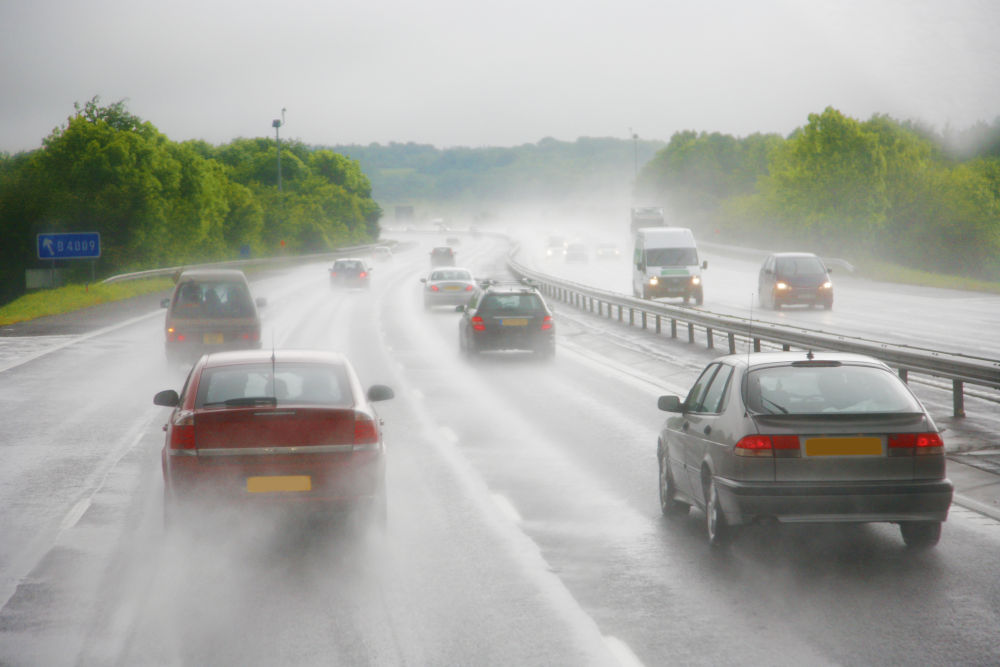
Stormy weather is unappealing at the best of times, and having to drive in it can be daunting. However, if you are careful and observe the right precautions you can navigate Britain’s roads safely and responsibly. We have prepared advice for driving in different stormy weather conditions so you can be confident and prepared when heading out on your journey.
Driving in the wind
Luckily, the UK is not affected by strong winds very often. The best advice is to reduce your speed, stay aware, and keep a firm grip on the steering wheel to keep control of your vehicle. You should take particular care on bridges or near cliffs as the wind will likely be stronger there. If you are driving at the bottom of a steep hill or beneath trees, reduce speed and be on the lookout for potential debris in the road. When driving near heavy goods vehicles (HGVs) be aware that their size makes them more easily moved by high winds. If you need to overtake one on a dual carriageway or motorway leave more room than you normally would and only move when it is safe.
Driving in the rain
Driving in the rain can be stressful but as long as you keep your wits about you and your eye on the road it can be done safely. The most important thing to do is stay alert and be aware of what other road users are doing around you, as well as the road ahead. Stopping distances double in wet conditions so leaving extra room between you and the car in front is essential to using the road safely. Other vehicles, particularly HGVs, will throw up spray from the road which can obscure your view, so extra distance is always a good policy. If you do need to slow down or stop, depress the brake gently rather than slamming it down. Braking too suddenly can cause you to lose traction on the slick road surface.
Driving in hail
While driving in a hailstorm can be intimidating, the good news is that hail can rarely cause anything more than cosmetic damage to your vehicle. While this isn’t ideal, it means that it is very possible to drive safely. Hailstorms are particularly challenging to drive in as they create both slippery conditions and reduce visibility. If you find the visibility is reduced to the point that you cannot safely navigate the road ahead, pull over at a safe place and wait for the storm to break. If you must continue travelling, leave a minimum of three car lengths between you and the vehicle in front. Build ups of hail can cause a similar phenomenon to aquaplaning or skidding on snow. If you feel your car begin to slide on a road covered in hail, don’t panic. Reduce speed by slowly removing your foot from the accelerator until completely off. Avoid using the brakes or making sudden movements with the steering wheel as this can cause you to skid.
Prepare for driving in storms
Before undertaking any long journeys, or driving in inclement weather, make sure you check your vehicle is safe. These checks are all quite straightforward but provide reassurance that you’ll be okay should bad weather strike.
-
Test your brakes
You can test that your brakes are operating properly by driving in normal conditions somewhere clear and empty. Accelerate to around 30mph (speed limits permitting) and brake. This should be a smooth process with no shaking or juddering.
-
Check lights and wipers
Visibility is key when driving in stormy weather. While stationary somewhere safe, check that your front and rear wipers function properly at full speed and refill the fluid is necessary. You can check that your lights are working even in the daytime by turning them on and having someone else verify they’re working, or while parked turning them on briefly to see if they are reflected in nearby windows or mirrors.
-
Check the pressure of your tyres
You can do this at a petrol garage or with a handheld device if you have one. The correct pressure will be either in your vehicle’s handbook (usually stored in the glovebox), on the inside of the fuel tank flap, or on the sill inside the driver’s side front door.
-
Assess your tyres’ tread depth
In wet conditions maintaining grip on the road surface is vital. You can assess that your tyres have the right tread depth by taking your vehicle to a professional, or at home by conducting the 20p test. Take a 20 pence piece, place it into the main groove of the tyre, and if the tyre covers the outer border of the coin the tread is deep enough. If you can still see the border, you may need to have your tyres replaced.
What is aquaplaning and what do I do if it happens to me?
When driving in wet conditions you may experience a build-up of water between the road and the tyres of your vehicle which causes them to lose traction. The steering may suddenly feel lighter, your engine becomes louder and unexpectedly revs, or the rear of your car might begin to drift. If you experience these then it is possible you are aquaplaning. If you find yourself aquaplaning slowly remove your foot from the accelerator and let your vehicle slow down. Try not to use the brakes unless absolutely necessary as this can cause you to skid which is extremely hazardous to you and other road users. You can mitigate against aquaplaning by reducing your speed in stormy conditions which will reduce the risk of the build-up of water occurring.
If you’re looking for more confidence on the road and would like professional instruction so you can handle everything the British weather can throw at you, contact Lanes School of Driving. We’ve been helping pupils get on the road for over a century and draw on that experience to deliver excellence in every lesson. To get started, get in touch with our team by calling 020 8166 5678 or emailing . We also provide driving instructor training for those looking to start a career in teaching others to drive.

